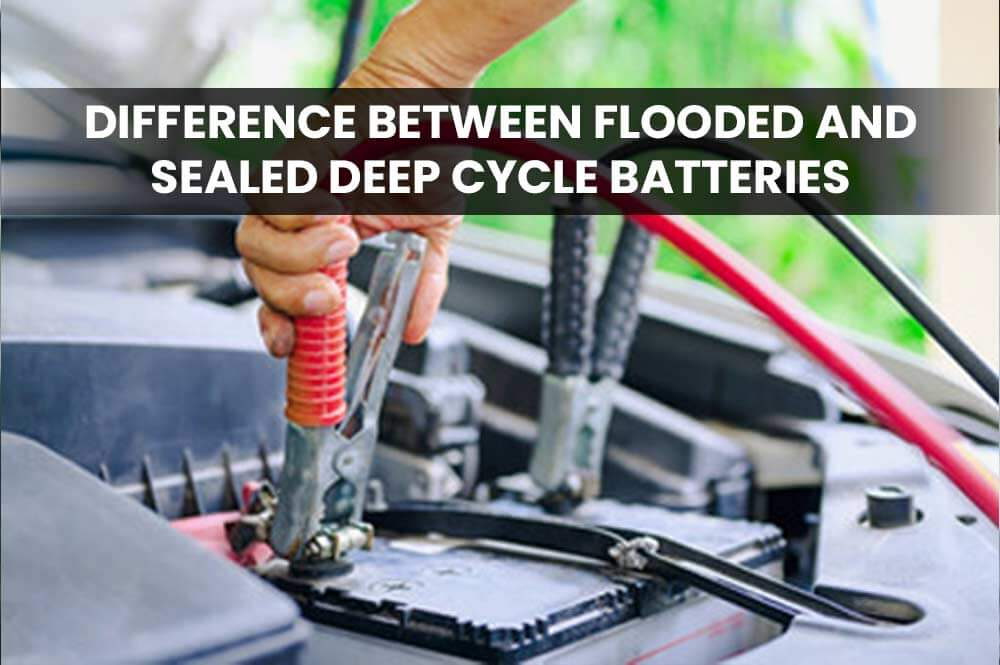Difference Between Flooded and Sealed Deep Cycle Batteries

When it comes to selecting the right deep cycle battery for your specific needs, it's important to consider the different types available and understand the key differences between them. In this article, we will take a closer look at two popular types of deep cycle batteries: Flooded and Sealed.
What is a Deep Cycle Battery?
A deep cycle battery is a rechargeable battery designed to be regularly deeply discharged and then recharged, as opposed to being used for brief periods only. They are commonly used in applications such as RVs, boats, off-grid energy systems, and golf carts, where a consistent power source is needed. Deep cycle batteries are designed to withstand repeated cycles of discharge and recharge and typically have a longer lifespan than other types of batteries.
Flooded Deep Cycle Batteries
Flooded deep cycle batteries are often used in applications that require a high level of power output, such as in recreational vehicles, boats, and off-grid solar systems. These batteries use liquid electrolyte, which is why they are also referred to as "wet cell" batteries. The liquid electrolyte is stored in individual cells, which are then sealed to prevent spillage.
One of the biggest advantages of flooded deep cycle batteries is that they are relatively low cost. They are also easier to repair and maintain compared to sealed batteries, as the electrolyte levels can be easily topped up if needed. However, they do require regular maintenance, such as checking the electrolyte levels and cleaning the terminals.
Sealed Deep Cycle Batteries
Sealed deep cycle batteries, also known as "maintenance-free" or "dry cell" batteries, are the preferred choice for applications that require a more compact, low maintenance solution. These batteries use absorbed glass mat (AGM) technology to store the electrolyte, which eliminates the need for maintenance and reduces the risk of spillage.
Sealed deep cycle batteries are also more environmentally friendly, as they contain no free-flowing liquids that can potentially leak and cause harm. They also have a longer lifespan compared to flooded batteries, as the AGM technology provides better protection against overcharging and deep discharge.
Types of Sealed Deep Cycle Batteries
1. Absorbed Glass Mat (AGM) is a type of sealed lead-acid battery that uses a fiberglass mat to absorb the electrolyte (sulfuric acid and water mixture) within the battery. The AGM design provides several advantages over traditional flooded lead-acid batteries, including:
Low Maintenance: AGM batteries are sealed, meaning that they do not require regular addition of water, making them low maintenance.
Spill-Proof: The fiberglass mat absorbs the electrolyte, preventing it from spilling, even if the battery is damaged.
High Power Density: AGM batteries have a high power density, making them a good choice for applications that require a lot of power in a small, compact package.
Fast Charging: AGM batteries can be charged faster than traditional flooded lead-acid batteries, which is beneficial for applications that require frequent and rapid recharging.
AGM batteries are widely used in deep cycle applications, such as RVs, boats, and off-grid energy systems, because of their reliability and low maintenance requirements.
2. GEL batteries are a type of sealed lead-acid battery that use a silica gel electrolyte instead of a liquid electrolyte. The gel electrolyte is a semi-solid substance that absorbs the sulfuric acid and water mixture, making the battery spill-proof and low maintenance. Some advantages of GEL batteries over traditional lead-acid batteries and AGM batteries include:
High Cycling Performance: GEL batteries have a longer cycle life and can be deeply discharged and recharged more times than traditional lead-acid batteries.
Improved Durability: GEL batteries are more tolerant of high temperatures and have a lower rate of self-discharge compared to traditional lead-acid batteries, making them more durable and longer-lasting.
Low Maintenance: GEL batteries are sealed, meaning they do not require regular addition of water, making them low maintenance.
Wide Operating Temperature Range: GEL batteries are designed to perform well in a wide range of temperatures, making them a good choice for applications that are exposed to extreme temperature conditions.
GEL batteries are commonly used in deep cycle applications, such as RVs, boats, and off-grid energy systems, because of their improved performance, durability, and low maintenance requirements.
Key Differences
When comparing flooded and sealed deep cycle batteries, there are several key differences to keep in mind:
Maintenance: Flooded batteries require regular maintenance, including checking the electrolyte levels and cleaning the terminals, while sealed batteries are maintenance-free.
Cost: Flooded batteries are typically more affordable compared to sealed batteries.
Environmental friendliness: Sealed batteries are more environmentally friendly, as they contain no free-flowing liquids that can potentially leak and cause harm.
Lifespan: Sealed batteries have a longer lifespan compared to flooded batteries, as the AGM technology provides better protection against overcharging and deep discharge.
Conclusion
When it comes to choosing the right deep cycle battery for your needs, it's important to consider the different types available and understand the key differences between them. Flooded deep cycle batteries are an affordable option that require regular maintenance, while sealed deep cycle batteries offer a low maintenance, environmentally friendly solution with a longer lifespan. Consider your specific needs and requirements, and make an informed decision based on the information provided above.
Shop battery from Batteries Store.